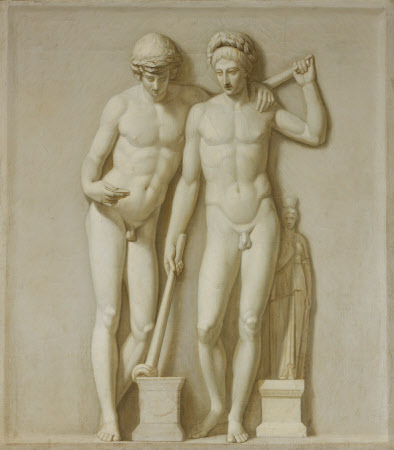Castor and Pollux
Robert Fagan (1761 - Rome 1816)
Category
Art / Oil paintings
Date
1793 - 1795
Materials
Oil on canvas
Measurements
1200 x 1048 mm (47 1/4 x 41 1/4 in)
Place of origin
Rome
Order this imageCollection
Attingham Park, Shropshire
NT 609090
Summary
Oil painting on canvas, Castor and Pollux by Robert Fagan (Cork c.1745 – Rome 1816), 1793/95. Grisaille panel of two naked youths, the heavenly twins as full-length figures, wearing laurel wreaths: the youth on the right, his weight resting on his left leg, stands between two small altars; he has a lighted torch held upside down in his right hand, the flame touching the small altar in the centre which is decorated with swags, his right arm is raised to his shoulder and he carries another torch behind his back, the second youth on the left, the weight on his right foot, looks down at a flat disk held in his right hand, and leans towards the other figure with his left arm around his shoulder. Behind the torch-bearer to the right is a small draped female figure on an altar. Based on the antique sculpture group, recorded in the Ludovisi collection in 1623 and by 1633 in the Palazzo Grande in the family estates on the Pincio. It was acquired from the Ludovisi by Cardinal Massimi and after his death bought by Queen Christina of Sweden. It was bequeathed to Cardinal Azzolini who died soon after her and his heir Marchese Pompeo Azzolini sold most of the collection's contents to Don Livio Odescalchi, nephew of Pope Innocent XI. His heir, Baldassare d' Erba sold Castor and Pollux to Philip V of Spain in 1724 and was in the palace of San Ildefonso until 1839 when it was taken to the Prado, Madrid where it remains. A plaster copy of the original antique statue group was kept at the French Academy in Rome. The identification of the group has been disputed but it is the name by which it has been commonly known. The twin brothers were called the 'Dioscuri', warriors, who were the sons of Zeus and had hatched from eggs laid by Leda after he had seduced her in the form of a swan. They are also the heavenly twins of the zodiac Gemini.
Provenance
Presumably commissioned by Thomas Noel Hill, 2nd Lord Berwick (1770-1832) on his visit to Naples in 1792/3; bequeathed to the National Trust in 1947 with the estate, house and contents of Attingham by Thomas Henry Noel-Hill, 8th Baron Berwick (1877-1947) on 15th May 1953.
Credit line
Attingham Park, The Berwick Collection (National Trust)
Makers and roles
Robert Fagan (1761 - Rome 1816), artist
References
Haskell and Penny 1981: Francis Haskell and Nicholas Penny, Taste and the Antique, The Lure of Classical Sculpture 1500 - 1900, New Haven and London, 1981

